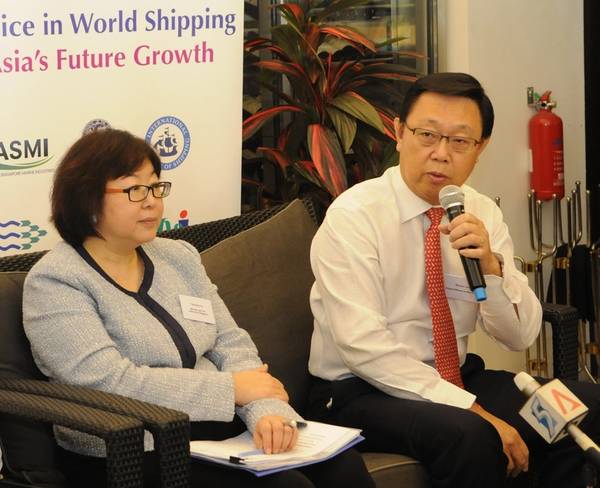
Maritime industry leaders have called for greater collaboration and consolidation in Asia to tackle challenges such as the rise over capacity, talent shortages and environmental sustainability, which are impacting the potential of the industry.
Speaking at an industry insights briefing today ahead of the launch of Sea Asia 2015, the Maritime and Port Authority (MPA) of Singapore Assistant Chief Executive (Development) Tan Beng Tee; PIL Managing Director and Singapore Maritime Institute (SMI) Chairman S.S. Teo; Singapore Maritime Foundation (SMF) Chairman and Keppel Offshore & Marine MD (Marine & Technology) Michael Chia; and Seatrade Chairman Chris Hayman, said the region’s maritime industry is facing significant growth opportunities but further collaboration and consolidation is needed.
The leaders at the conference said consolidation and stronger alliances across public and private sector would help navigate these challenges.
The world’s container fleet stood at 5,043 vessels at the end of 2013, up from 5,010 at the end of 2012, with excess capacity amplified through the introduction of larger vessels. This has led to an oversupply which impacts the profitability of the industry.
“We will see further consolidation,” Teo added. “It is a matter of bringing people together to realize the challenges and the opportunities, and look at how we can overcome them together.”
He added that it’s not all about size and scale.
“We are seeing ships continuing to get bigger and bigger and a lot of focus on scale. However we need to remain equally focused on the ‘softer side’ of shipping such as customer service and information technology,” he said.
Collaboration is also important to tackle the shortage of highly trained talent within the industry and environmental sustainability.
The world fleet is expanding at a rate of 2.3 percent per annum, fast outstripping the supply of global maritime talent. A recent BIMCO report highlighted that the world’s global supply of 624,000 officers falls 13,000 short of demand with 4,500 fewer workers employed in Singapore’s maritime sector in 2012, versus the previous year.
Maritime centers across Asia are working to address this challenge. Singapore, for example, has a number of initiatives in place. Its Maritime Cluster Fund – Manpower Development (MCF-MD) was established to develop and attract talent. In 2013 alone, MPA provided co-funding support to more than 4,400 participants of maritime training through the MCF-MD.
Tan commented that MPA is focused on developing a “pipeline of strong Singaporean talent”. The development of new technology as well as the increased productivity of the existing workforce will help reduce the demand for as many human resources.
“We also need to work together to share ideas and technology to develop more environmentally-friendly solutions,” Teo said.
“This is one focus area under the SMI Research and Development (R&D) Roadmap. We are planning an R&D program to pursue issues and opportunities related to ballast water and exhaust emission, among others,” he said.
Chia commented that by working together to overcome these challenges, the maritime industry in Asia is set for future growth.
“The basic driving force behind shipping will be the growth of the Asian economies. We see China continuing to grow. ASEAN has a reasonable growth pace; India is coming up and Vietnam is a hidden tiger. These economies will continue to sustain shipping.”
He added this is already clearly demonstrated in the region’s growing prominence in a number of critical areas, such as ship building. Asia now controls more than 90 percent of the shipbuilding market, with China alone accounting for around 44 percent of the current global order book for new ships[1].
Seatrade Chairman Chris Hayman said: “Asia is the world’s engine room for growth.”
"Increasing intra-and-extra regional trade, a rapidly growing ‘consuming class’ and emerging economies are all fuelling fast-paced growth in the region’s maritime industry. However, there are a number of challenges that the region needs to navigate,” he said.
MPA’s Tan agreed that Asia was fast growing in prominence. She commented, “The opportunities for partnership and collaboration in the region are undoubtedly on the rise. With her strategic location and pro-business environment, Singapore is positioned well as a gateway to key Asian markets. Singapore continues to keep abreast of global developments and will continue to work with the industry to address and tackle key challenges and position ourselves strategically for future growth.”
Indeed, the challenges and opportunities facing the region’s maritime industry will be the focus of next year’s Sea Asia – an event which has firmly established its position as the leading platform for discussion, debate and analysis on the maritime industry.
“Sea Asia’s importance in the global maritime calendar continues to grow,” Hayman said.
“Last year’s exhibition was attended by over 13,000 participants from 68 countries, and featured 385 maritime businesses from 39 countries. Next year’s event will be even bigger.
“The exhibition will grow by over 30 percent to accommodate greater interests and showcase of more services and new products. The opening session of the Sea Asia conference which has traditionally been drawing the Who’s Who of maritime leadership, will be upgraded in terms of format and content.
“We have confirmed the participation of journalist and broadcaster, Stephen Sackur, who will undoubtedly keep us all on the edge of our seats as he leads a grueling debate of key maritime issues,” he said.



